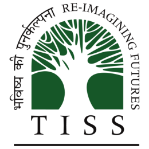

Prof. Manoj Kumar Tiwari
Vice Chancellor, TISS, Chairman-Western Zone, Viksit Bharat @2047



As notified by UGC letter D.O. No.F.1-1/2024 (Secy/Viksit Bharat) dated 13th March, 2024, Prof Manoj
Kumar Tiwari, Vice Chancellor, Tata Institute of Social Sciences, is Chairman-Western Zone, Viksit
Bharat@2047. Twenty six (26) Universities are listed under Western Zone and TISS is one of the
Universities.
Numerous students workshops, and brainstorming initiatives with various stakeholders, to gather
suggestions and views on different Sectoral Visons identified under UGC proposal for Viksit Bharat@2047,
will be initiated by the University. To capture youth vision and ideas, the University shall conduct
workshops and brain-storming deliberations. Students to actively contribute their ideas and perspectives
on their roles in shaping the Viksit Bharat by 2047
SCHEDULE OF WORKSHOPS/BRAINSTORMING SESSIONS

Hamara Sankalp Viksit Bharat 2047 Public Lecture on BHARAT as VISHWABANDHU
4th April 2024|4:00 P.M.

Viksit Bharat@2047 : Western Zone Sustainable Economy and Industry of the Future
3rd April 2024|3:00 P.M.

Youth Voices for Building Citizenship
1st April 2024|3:00 P.M.

Socio-Legal Strategies for Dealing with Cyber Crimes: Voice of Youth School of Law, Rights & Constitutional Governnce (SLRCG)
28 March 2024|3:00 P.M.

Nari Shakti in 21st Century - Role of Progressive Women in Integrating India with Knowledge of Social Science and Advanced Technologies
29 March 2024|5:30 P.M.

Agriculture and Rural Economy Brainstorming session (Youth's Voice)
27 March 2024|10:00 P.M.

Dr. B. R. Ambedkar Memorial Lecture: Reflection on Inclusive Society (Youth Voices)
23 March 2024|06:00 P.M.

Students’ Workshop on Skill Education in Higher Education Institutions (HEIs) and Industry Integration
22 March 2024|03:00 P.M.
Concept Note for Discussion with Universities on Vision for 2047
- Sports – Through concerted efforts of Khelo India, we are breaking past records and have crossed the 100-mark in medals in the recent Asian Games.
- Jan Dhan Accounts – In a short period, we added 40 crore bank accounts ensuring financial inclusion, something that people expected would take years.
- COVID Vaccines – The COVID vaccination programme, run through the COWIN platform, with indigenous COVID-19 vaccines, was the world’s largest vaccination programme delivered to 200 crore recipients flawlessly. This is a public health achievement without a parallel in human history. We also helped save millions of lives across the world through the Vaccine Maitri initiative, providing 23.5 crore COVID vaccines free of cost to 98 countries. This is a testament to India’s commitment to global health and wellbeing.
- Chandrayaan – India’s Mission to the Moon and becoming the first country to land on the South Pole of the moon demonstrated our excellence in science, breaking boundaries in an economical way. This has surprised the leading nations of the world and is an inspiration for what can be achieved on a limited budget and an encouragement for the great tasks that lie ahead in science and technology. India’s unique model of frugal innovation can be characterised as ‘affordable excellence’ and is a beacon for other countries.
- Climate Goals – India is the only country which has overachieved its Paris 2015 climate commitments 9 years ahead of time by meeting 40% of its power capacity from non-fossil fuels. This has raised our global standing.
- Digital Public Infrastructure – The DPI we set up has been expanded at a blinding speed, allowing India to be a world leader in digitisation.
- Infrastructure Expansion – The rapid expansion of state-of-the-art infrastructure is another example of improved capabilities. In the last 9 years, the pace of railway track construction increased more than 3 times from 1,452 km/year to 5,243 km/year. The National Highways Network has increased by 60% to 1,45,240 kms. There has been 100% growth in Airports from 74 to 148.
- India’s Global Standing – As a world leader, our Presidency of the G20 saw the world respecting India’s diplomatic and organisational capabilities. We took G20 sessions to every corner of India and the New Delhi Leaders’ Declaration is a milestone in India’s history. With India’s global standing rising, international institutions like the International Solar Alliance are now being set up in India and international investors are coming to India in large numbers. In many ways, India is leading the world. These dramatic improvements have happened because of a comprehensive governance model that focused on leaving no one behind with speed of service delivery, transparency of operations and focusing on impact at the grassroots and on outcomes. This is also because of a singular commitment to a long-term vision for India.
- How should a Viksit Bharat look like in 2047 in different aspects?
- What do we need to do to reach those goals?
- Empowered Indians
- Thriving and Sustainable Economy
- Innovation, Science & Technology (Research & Development, Digital, Startups)
- Good Governance and Security
- India in the World
Viksit Bharat @ 2047 - SoP for different Stakeholders
Viksit Bharat @ 2047 - Vision











Ideas for the Vision of Viksit Bharat @ 2047
Viksit Bharat @ 2047: Voice of Youth
M2M Programme - Viksit Bharat @ 2047

Events
Sustainable Economy and Industry of the Future


Public Lecture on BHARAT as VISHWABANDHU


School of Law, Rights & Constitutional Governnce (SLRCG)


Brainstorming session (Youth's Voice)







The Hon'ble Prime Minister, Shri Narendra Modi laid the foundation stone for three semiconductor facilities at Dholera and Sanand (Gujarat), and Morigaon (Assam) in a virtual ceremony on 13 March 2024. The ceremony, which was live streamed was attended by students, staff and faculty of TISS Mumbai.
The background note sent by the University Grants Commission of India states that the country's "Semi-Conductor Mission has been set up by the Government of India to create an end-to-end semi-conductor eco-system to enable the nation to become a significant player in the global semi-conductor industry." The laying of the Foundation stone aligns with the Mission and is in pursuit of the vision of a #ViksitBharat.
VIKSIT BHARAT@2047, Western Zone Schedule of Workshops/ Brainstorming Sessions
TATA INSTITUTE OF SOCIAL SCIENCES
VIKSIT BHARAT@2047, Western Zone
Schedule of Workshops/ Brainstorming Sessions
|
S. No. |
Thematic Area |
Name of Convenor |
Date of Workshop |
Venue |
|
1. |
Skill Education in Higher Education Institutions (HEIs) and Industry Integration |
Prof. Madhushree Sekher |
22nd March, 2022 At 03.00pm
|
Prof. Armaity Desai Conference Hall, TISS Main Campus, Mumbai |
|
2. |
Reflections on Inclusive Society |
Prof. Avatthi Ramaiah |
23rd March, 2022 At 06.00pm |
Convention Centre, TISS New Campus, Mumbai |
|
Agriculture and Rural Economy |
Prof. Ramesh Jare
|
27th March, 2024 At 03.00pm |
Tuljapur Campus |
|
|
4. |
Startup Ecosystem and Entrepreneurship for Future (Part I- with Students) |
Prof. Satyajit Majumdar |
27th March, 2024 At 10.00am |
Prof. S. Parsuraman Conference Hall (Library Conference Hall), TISS Main Campus, Mumbai |
|
5. |
Nari Shakti in 21st Century - Role of Progressive Women in knitting social fabric of India with Advance Technologies |
Dr. Vaishali Kolhe |
28th March, 2024 At 05.30pm |
Prof. S. Parasuraman Conference Hall (Library Conference Hall), TISS Main Campus, Mumbai |
|
6. |
Socio-legal strategies for dealing with Cyber Crimes |
Prof. Arvind Tiwari |
29th March, 2024 At 03.00pm |
Prof. Armaity Desai Conference Hall, TISS Main Campus, Mumbai |
|
7. |
Startup Eco-system and Entrepreneurship for Future (Part II- with Alumni/ Industries) |
Prof. Satyajit Majumdar |
1st April, 2024 At 10.30am
|
Prof. Armaity Desai Conference Hall, TISS Main Campus, Mumbai |
|
8. |
Youth Voices for Building Citizenship |
Prof. Ashwani Kumar |
1st April, 2024 At 03.00pm |
Prof. Armaity Desai Conference Hall, TISS Main Campus, Mumbai |
|
9. |
Hamara Sankalp Viksit Bharat 2047- Public Lecture on BHARAT as VISHWABANDHU |
Prof. Shankar Das |
2nd April, 2024 At 04.00pm
|
Prof. S. Parasuraman Conference Hall (Library Conference Hall), TISS Main Campus, Mumbai |
|
10. |
Sustainable Economy and Industry of the Future - TISS Students and IIM Mumbai |
Prof. Zubin Mulla/ Prof. Madhushree Sekher |
3rd April, 2024 At 03:00pm |
Prof. Armaity Desai Conference Hall, TISS Main Campus, Mumbai/IIM Mumbai |
|
11. |
Indian Holistic |
Prof. Shankar Das |
(TBD) |
Prof. Armaity Desai Conference Hall, TISS Main Campus, Mumbai |
Vice Chancellor, TISS,Is Chairman-Western Zone,Viksit Bharat @ 2047












